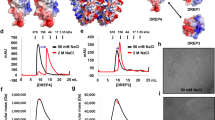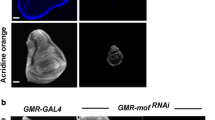Abstract
DNA fragmentation is common phenomenon for apoptotic cell death. DNA fragmentation factor, called DFF40 (CAD: mouse homologue), is a main nuclease for apoptotic DNA fragmentation. Nuclease activity of DFF40 is normally inhibited by DFF45 by tight interaction via CIDE domain without apoptotic stimuli. Once effector caspase is activated during apoptosis signaling, it cleave DFF45, allowing DFF40 to enter the nucleus and cleave chromosomal DNA. Unlike mammalian system, apoptotic DNA fragmentation in the fly might be controlled by four DFF-related proteins, known as Drep1, Drep2, Drep3 and Drep4. Although the function of Drep1 and Drep4 is well known as DFF45 and DFF40 homologues, respectively, the function of Drep2 and Drep3 is still unclear. DFF-related proteins contain a conserved CIDE domain of ~90 amino acid residues that is involved in protein–protein interaction. Here, we showed that Drep1 directly bind to Drep2 as well as Drep4 via CIDE domain. In addition, we found that the interaction of Drep2 and Drep4 to Drep1 was not competitive indicating that Drep2 and Drep4 bind different place of Drep1. All together, we suggest that Drep1 might be involved in apoptotic DNA fragmentation of fly system by direct interaction with Drep2 as well as Drep4.






Similar content being viewed by others
References
Kerr JF, Wyllie AH, Currie AR (1972) Apoptosis: a basic biological phenomenon with wide-ranging implications in tissue kinetics. Br J Cancer 26:239–257
Rathmell JC, Thompson CB (2002) Pathways of apoptosis in lymphocyte development, homeostasis, and disease. Cell 109(Suppl):S97–107
Vazquez A, Bond EE, Levine AJ, Bond GL (2008) The genetics of the p53 pathway, apoptosis and cancer therapy. Nat Rev Drug Discov 7:979–987
Cotter TG (2009) Apoptosis and cancer: the genesis of a research field. Nat Rev Cancer 9:501–507
Beutler B (2001) Autoimmunity and apoptosis: the Crohn’s connection. Immunity 15:5–14
Lorenz HM, Herrmann M, Winkler T, Gaipl U, Kalden JR (2000) Role of apoptosis in autoimmunity. Apoptosis 5:443–449
Nagata S (2000) Apoptotic DNA fragmentation. Exp Cell Res 256:12–18
Liu X, Zou H, Slaughter C, Wang X (1997) DFF, a heterodimeric protein that functions downstream of caspase-3 to trigger DNA fragmentation during apoptosis. Cell 89:175–184
Enari M, Sakahira H, Yokoyama H, Okawa K, Iwamatsu A, Nagata S (1998) A caspase-activated DNase that degrades DNA during apoptosis, and its inhibitor ICAD. Nature 391:43–50
Susin SA, Lorenzo HK, Zamzami N et al (1999) Molecular characterization of mitochondrial apoptosis-inducing factor. Nature 397:441–446
Lorenzo HK, Susin SA, Penninger J, Kroemer G (1999) Apoptosis inducing factor (AIF): a phylogenetically old, caspase-independent effector of cell death. Cell Death Differ 6:516–524
Lechardeur D, Drzymala L, Sharma M et al (2000) Determinants of the nuclear localization of the heterodimeric DNA fragmentation factor (ICAD/CAD). J Cell Biol 150:321–334
Kawane K, Fukuyama H, Adachi M et al (1999) Structure and promoter analysis of murine CAD and ICAD genes. Cell Death Differ 6:745–752
Sakahira H, Enari M, Nagata S (1999) Functional differences of two forms of the inhibitor of caspase-activated DNase, ICAD-L, and ICAD-S. J Biol Chem 274:15740–15744
Tang D, Kidd VJ (1998) Cleavage of DFF-45/ICAD by multiple caspases is essential for its function during apoptosis. J Biol Chem 273:28549–28552
Inohara N, Nunez G (1999) Genes with homology to DFF/CIDEs found in Drosophila melanogaster. Cell Death Differ 6:823–824
Mukae N, Yokoyama H, Yokokura T, Sakoyama Y, Sakahira H, Nagata S (2000) Identification and developmental expression of inhibitor of caspase-activated DNase (ICAD) in Drosophila melanogaster. J Biol Chem 275:21402–21408
Yokoyama H, Mukae N, Sakahira H, Okawa K, Iwamatsu A, Nagata S (2000) A novel activation mechanism of caspase-activated DNase from Drosophila melanogaster. J Biol Chem 275:12978–12986
Park OK, Park HH (2012) Dual apoptotic DNA fragmentation system in the fly: Drep2 is a novel nuclease of which activity is inhibited by Drep3. FEBS Lett 586:3085–3089
Lugovskoy AA, Zhou P, Chou JJ, McCarty JS, Li P, Wagner G (1999) Solution structure of the CIDE-N domain of CIDE-B and a model for CIDE-N/CIDE-N interactions in the DNA fragmentation pathway of apoptosis. Cell 99:747–755
Otomo T, Sakahira H, Uegaki K, Nagata S, Yamazaki T (2000) Structure of the heterodimeric complex between CAD domains of CAD and ICAD. Nat Struct Biol 7:658–662
Schwede T, Kopp J, Guex N, Peitsch MC (2003) SWISS-MODEL: an automated protein homology-modeling server. Nucleic Acids Res 31:3381–3385
Laskowski RA, Rullmannn JA, MacArthur MW, Kaptein R, Thornton JM (1996) AQUA and PROCHECK-NMR: programs for checking the quality of protein structures solved by NMR. J Biomol NMR 8:477–486
DeDeLano, Warren L (2002) The PyMOL Molecular Graphics System. DeLano Scientific, San Carlos
Park HH (2011) Structural analysis of death domains and their interactions. Apoptosis 16:209–220
Park HH (2012) PYRIN domains and their interactions in the apoptosis and inflammation signaling pathway. Apoptosis 17:1247–1257
Acknowledgments
This research was supported by a grant from the Korea Healthcare Technology R&D Project, Ministry of Health & Welfare, Republic of Korea (A100190) and Basic Science Research Program through the National Research Foundation of Korea (NRF) funded by the Ministry of Education, Science and Technology (2011-0025697 and 2012-010870).
Author information
Authors and Affiliations
Corresponding author
Rights and permissions
About this article
Cite this article
Park, O.K., Park, H.H. A putative role of Drep1 in apoptotic DNA fragmentation system in fly is mediated by direct interaction with Drep2 and Drep4. Apoptosis 18, 385–392 (2013). https://doi.org/10.1007/s10495-013-0815-9
Published:
Issue Date:
DOI: https://doi.org/10.1007/s10495-013-0815-9




